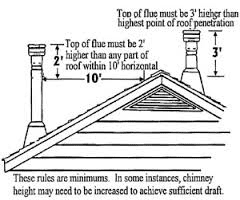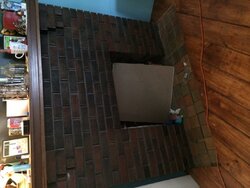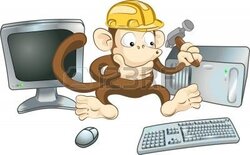Been like this since I started, like I said once I light paper in my clean out it drafts normal but once any part of it cools it wants to all cool NOW. That's the worry, it is triple wall class a insulated pipe. 36" sticks.
Everything's cooling down
- Thread starter Cta2885
- Start date
-
Active since 1995, Hearth.com is THE place on the internet for free information and advice about wood stoves, pellet stoves and other energy saving equipment.
We strive to provide opinions, articles, discussions and history related to Hearth Products and in a more general sense, energy issues.
We promote the EFFICIENT, RESPONSIBLE, CLEAN and SAFE use of all fuels, whether renewable or fossil.
You are using an out of date browser. It may not display this or other websites correctly.
You should upgrade or use an alternative browser.
You should upgrade or use an alternative browser.
- Status
- Not open for further replies.
Bagelboy
Feeling the Heat
Like I said before, the easiest, and by far solution is more draft. Add more pipe! If you have a strong draft, it will let the fire continue to burn.
Ashful
Minister of Fire
Adding more pipe will intensify weak draft. Please explain how it will reverse a draft reversal. I don't see this as the solution to this problem, but I've been wrong before.Like I said before, the easiest, and by far solution is more draft. Add more pipe! If you have a strong draft, it will let the fire continue to burn.
Sorry, in regards to an earlier post I made on page two. I have a chimney that goes up through my house, it looks to be for an old fireplace. Sorry about the stuff in the base of it. But here's a pic, like I said the chimney of it only has a few pieces of insulation and plywood holding them up.
Attachments
Ashful
Minister of Fire
This was sort of glossed over, but I think it's worth investigating. Can anyone else comment on this?Draft is achieved by hot air rising through the chimney pipe. Your chimney is and air cooled insulated hybrid that should not be used in your application because it will not hold heat inside the flue pipe very well.... So you need to supplement the heat loss and the Draw Collar is made to do just that. To start a fire you turn on the collar, it heats the stove pipe causing a draft to start. When the fire starts to tail off the Collar senses the low heat and turns back on increasing draft.
hiites
Member
Sorry, in regards to an earlier post I made on page two. I have a chimney that goes up through my house, it looks to be for an old fireplace. Sorry about the stuff in the base of it. But here's a pic, like I said the chimney of it only has a few pieces of insulation and plywood holding them up.
This could very well be your issue. I would definitely try to seal it better and see what difference it makes.
hiites
Member
What is the pitch on your roof? If you have a 4/12 pitch, you are way short on chimney height. If you have 4.5" above the edge of the eave, you are even short for a 3/12 pitch.And sorry I overlooked a few questions. Where my house is located, I have houses on both sides of me, unfortunately I only had one place to set the stove, in which I had to run the through the wall kit and up the side of the house. It extends roughly (this is an eye measurement right now) 4.5' above the edge of my eaves. Which makes the proper measurements for fire code, insurance and manufacturer specs.
Wind, well there always seems to be a breeze around the house. So I do have a breeze all around the house
I am not sure what the pitch is. All I know is The pitch is steep, to the point where snow slides off, and for safety I had to put an anchor system on to even climb on, even sometimes I have to mount a ladder to get to the peak. I am up on my chimney so the measurement from the tip to the nearest point of my roof across measures 11 feet. I guess I'll add another stick and see. As well as seal my non working chimney
hiites
Member
I am not sure what the pitch is. All I know is The pitch is steep, to the point where snow slides off, and for safety I had to put an anchor system on to even climb on, even sometimes I have to mount a ladder to get to the peak. I am up on my chimney so the measurement from the tip to the nearest point of my roof across measures 11 feet. I guess I'll add another stick and see. As well as seal my non working chimney
Measure to where the chimney is 10' from the roof and make sure you are 2' above that.

Ok, so if I am reading that diagram correctly, I am seeing I have to be 2' above the peak of my roof?
If that is the case there would be no way of cleaning it due to the height of the stack and the pitch of my roof. Let alone safely put it up.
Does anyone know if the vaccu stack actually works the way they say it does?
If that is the case there would be no way of cleaning it due to the height of the stack and the pitch of my roof. Let alone safely put it up.
Does anyone know if the vaccu stack actually works the way they say it does?
Ashful
Minister of Fire
Only if your roof peak is within 10 feet of the chimney.Ok, so if I am reading that diagram correctly, I am seeing I have to be 2' above the peak of my roof?
There are many, many, many installs where it is not possible to reach the top of the stack while standing on the roof. They're discussed here every week, mostly in cases of steep-pitch roofs. It's just a common fact of life. I have more than one on my house.
You clean one of several ways:
1. Bottom up.
2. Cherry picker or lift.
3. Scaffolding
4. Ladder against a masonry stack (this is my case).
Seasoned Oak
Minister of Fire
That is correct. Even cold it should draft a little.Cta, Just another point for clarity, your chimney should draft at least a little even when cold.
Seasoned Oak
Minister of Fire
I am assuming he is trying to light the woodstove while at least one other appliance is drawing inside air. Yes if it downdrafts with no other appliance operating, than that is unusual. Should have some draft when other appliances are idle.Seasoned, believe me I'm not saying you don't have a point but if the chimney is down drafting w/ the furnace and everything else off don't you have to correct that first? If it was drafting (even poorly) and the furnace coming on caused a problem then the OAK might fix it. Am I crazy?
See exactly, I have tried it with absolutely nothing running, unplugged, switches off everything and still get downdraft.
I just do not understand why I wouldn't get any draft at all until I put paper in te clean out and light it to warm up the chimney
I just do not understand why I wouldn't get any draft at all until I put paper in te clean out and light it to warm up the chimney
And also I am 11 feet off my roof to the tip of the last piece of class a insulated, not the cap.
Seasoned Oak
Minister of Fire
Once it starts(downdraft) It usually dont stop on its own. Sometimes when its warm out ,and i dont fire up the stove for a day or two and i get a burntwood smell in the stove room,i know its a downdraft pushin air out thru the woodstove intakes from the chimney. By the same token once the draft is going the correct way UP the flue it usually is self sustaining,but another drafting appliance will cause it to reverse if that flue gets cold.See exactly, I have tried it with absolutely nothing running, unplugged, switches off everything and still get downdraft.
I just do not understand why I wouldn't get any draft at all until I put paper in te clean out and light it to warm up the chimney
Fireshoppe
New Member
That is correct. Even cold it should draft a little.
I disagree.
Open the door on a stove with a cold chimney and feel the air fall out of the stove onto your feet. Cold air is 'heavier' than warm air. Warmer air rises through cooler air. Hot air rises. Without it there is no draft. In fact the opposite.
This quote is from the CSIA
"A chimney is called a negative pressure system. Increasing the draft in your chimney is like opening the faucet wider on the hose. The simplest way to increase the draft in your chimney is to burn the fire hotter - hotter air is lighter, so it has more pull."
It is possible the higher levels of the home and another open flue may compete but from the OP's very first paragraph the issue has been stated that he has to preheat the flue to start a draft and once the fire begins to die the 'stove' starts to smoke. i.e. loss of draft from loss of heat in the air cooled exterior chimney. So, a stable DRAFT must be established in the flue before other complications can be identified and dealt with. It does little good to speculate about make up air or stove pipe angle or anything else until he is able to put enough heat into the flue to make it DRAW consistently. IMHO
Seasoned Oak
Minister of Fire
I have flues and stoves in several locations that are normally cold. Ranging from 25Ft to 40 Ft One is 12" and the other 2 are smaller. All have a small draft when cold. My own home only developes a negative draft in a cold flue, when another appliance is activated creating a low pressure situation.I disagree.
Open the door on a stove with a cold chimney and feel the air fall out of the stove onto your feet. Cold air is 'heavier' than warm air. Warmer air rises through cooler air. Hot air rises. Without it there is no draft. In fact the opposite.
. IMHO
Fireshoppe
New Member
Cold is relative sir. What I mean is the OP has an extreme installation and I believe (without rereading) he has said his system down drafts when cold but updrafts when warm.
Have a look at the install, if I am correct in understanding his choice of chimney system (Duraplus) I can't think of a system more susceptible to cold air inversions. I am sure that under these circumstances the stack effect of his home comes into play as the flue temps decrease but maintaining adequate temps is the first step to success.
Have a look at the install, if I am correct in understanding his choice of chimney system (Duraplus) I can't think of a system more susceptible to cold air inversions. I am sure that under these circumstances the stack effect of his home comes into play as the flue temps decrease but maintaining adequate temps is the first step to success.
Last edited:
velvetfoot
Minister of Fire
I get downdraft on a cold stack, it seem almost any time of year, no other appliances, first floor, 24', chase.
I do use duraplus duravent class a triple wall air insulated.
So what you're saying fireshoppe is that they are very susceptible to the issue I am having?
So what you're saying fireshoppe is that they are very susceptible to the issue I am having?
Fireshoppe
New Member
I do use duraplus duravent class a triple wall air insulated.
Air cooled is the correct term. While the inner pipe is insulated with 1/2" of ceramic, that is surrounded by a ventilated air jacket which as heat is dissipated into the air space allows the heat to be carried away up and out into the atmosphere. In an interior installation this system provides a safe installation which naturally stay warmer due to higher ambient temperatures (but also removes air from the dwelling). But in you outdoors installation the thin insulation surounded ny higher velocity moving air cools of the internal flue temps much more quickly.
So because your flue looses the internal heat required for a good long term draft you have (as I see it) 3 choices.
1. Draw Collar
2. Replace chimney with a 2" insulated system like this http://www.securitychimneys.com/residential/chimneys/SecureTempS2100/
3. Build an insulated chase on the exterior of your home like this http://www.securitychimneys.com/resources/photo/HT6103_installation_exterior_wood-stove.jpg
http://www.google.com/url?sa=i&rct=...w7QOgsTx-DPmMD9SoDBmVROg&ust=1389753714572024
http://www.securitychimneys.com/resources/photo/HT6103_installation_exterior_wood-stove.jpg
Bagelboy
Feeling the Heat
You can't get draft reversal if you have a really strong draft. This is why I keep saying you need to lengthen your chimney. If it is higher, it will pull like a freight train! I would also block up the entrance to the other chimney and see if this is pulling from inside the house. Even if it is not effecting your current chimney, it may be drawing heat from your home.
Last edited:
Ashful
Minister of Fire
Seasoned Oak
Minister of Fire
Gas furnaces typically have an open draft hood that continually pulls air from the home to maintain draft whether the stove is running or not.
- Status
- Not open for further replies.
Similar threads
- Replies
- 2
- Views
- 882
- Replies
- 0
- Views
- 1K
- Replies
- 1
- Views
- 574
- Replies
- 11
- Views
- 479



